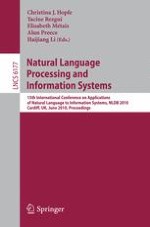th The 15 International Conference on Applications of Natural Language to Information Systems (NLDB 2010) took place during June 23–25 in Cardiff (UK). Since the first edition in 1995, the NLDB conference has been aiming at bringing together resear- ers, people working in industry and potential users interested in various applications of natural language in the database and information system area. However, in order to reflect the growing importance of accessing information from a diverse collection of sources (Web, Databases, Sensors, Cloud) in an equally wide range of contexts (- cluding mobile and tethered), the theme of the 15th International Conference on - plications of Natural Language to Information Systems 2010 was "Communicating with Anything, Anywhere in Natural Language. " Natural languages and databases are core components in the development of inf- mation systems. Natural language processing (NLP) techniques may substantially enhance most phases of the information system lifecycle, starting with requirement analysis, specification and validation, and going up to conflict resolution, result pr- essing and presentation. Furthermore, natural language-based query languages and user interfaces facilitate the access to information for all and allow for new paradigms in the usage of computerized services. Hot topics such as information retrieval (IR), software engineering applications, hidden Markov models, natural language interfaces and semantic networks and graphs imply a complete fusion of databases, IR and NLP techniques.
